Chris & Allyson vs. Italy & Croatia (June-July 2019)
Italy Day Four: Vatican Museums, Spanish Steps, Villa Borghese
Our fourth day in Rome, we had to walk to another country. But we didn't have to be there until 11 a.m., so we slept in a little. Enjoyed breakfast on the hotel roof. Got a little loose first. Then it was off to see the pope, because you can't spell "vacation" without "Vatican."
I was raised Catholic, and I thought it was cool that the world's top Catholic gets to have his own private country. Allyson was not raised Catholic, but she enjoys huge mansions. So this visit was a win-win. Vatican City has been doing its own thing since 1929, although this was more of a consolation prize than a triumphant achievement for Team God. The popes used to control a lot more territory, but the founders of the Kingdom of Italy understandably didn't want a backseat driver with a direct line to heaven. Maybe they also maybe didn't want to pay the upkeep on the world's most insane art collection / church / palace. So the world's smallest country was born.
As of 2019, the Vatican is also one of the world's greatest tourist attractions, because the church has been pretty open-minded about squeezing millions of dollars out of tourists. In the high season, the Vatican is like all the great Roman attractions: Reserve ahead, or stand in line. Since the high season corresponds with the "unbearably hot" season, planning ahead is next to godliness. Staying on brand, the line for the Vatican was of Biblical proportions. We had tickets for an 11 a.m. tour on a Tuesday, so we timed it to arrive at St. Peter's Square around 10:30ish. That was almost a mistake. The complex is so big that walking around the outer wall to the tour entrance took maybe another 10 minutes. And we passed huge queues stretching down a very long block. At the visitor center, the crowd was so thick that you had to force your way through just to find the special ticket window for advance reservations. They gave us some special closed-circuit radios, pointed us to a small clearing on the edge of the room, where we posted up, surveyed the throng and hoped we were in the right space. If we weren't, we were out of luck. Moses himself couldn't have parted the lobby to let us through.
We were also sweating like the Israelites, because we made a token effort at dressing up. The Vatican websites ask that gentlemen wear pants and ladies cover their shoulders. It was in the high 90s, but our general understanding that the inner circles of Hell are much hotter, so we complied with the code. Standing in the lobby, we regretted our decision: Divine wrath apparently strikes no fear in the heart of American tourists or Eurotrash. I was looking forward to Inquisitors publicly flogging anyone showing up in "Juicy" shorts, but no one said anything to anyone.
But suffering is really important to a true Catholic experience, and our faith was rewarded with another great guide. Her (Anglicized) name was Barbara. She was a very attractive Italian woman with an art degree. She was a wonderfully engaging speaker, although you needed the radios to know this, because it was almost impossible to hear her without them. The lines outside the Vatican were a great preview for the crowds inside. Theoretically you can stroll around at your leisure, if you consider combat sports to be a leisure activity. In high season the Vatican Museums operate like a cattle chute, with herds of tourists slowly proceeding through a panoply of artistic glory. Grandmothers were once notorious for putting plastic on ugly couches to protect them. The Vatican is clearly not run by grandmothers; almost every day, it invites a mosh pit to plow through its priceless treasures.
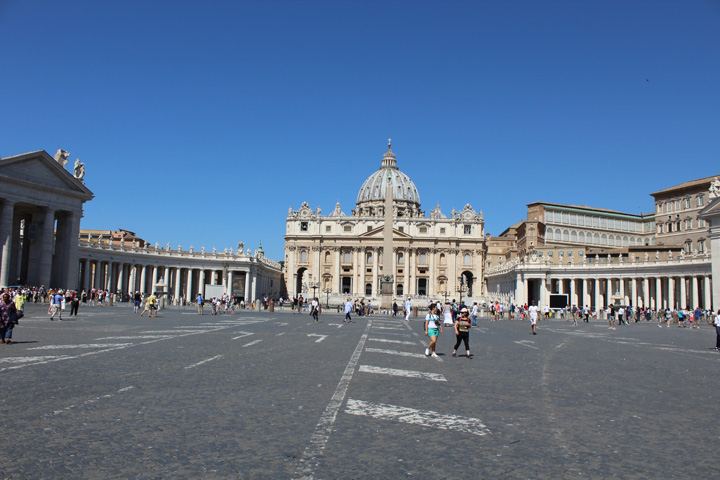
St. Peter's, one of the most holy tourist sites on the planet.
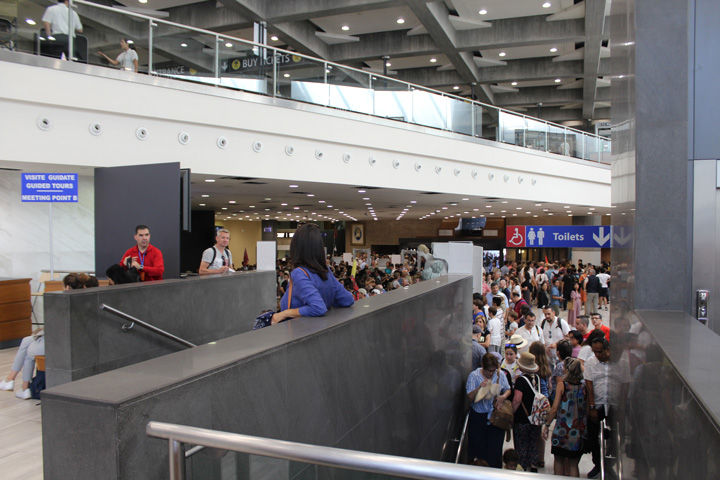
Not that far from the madding crowd: The Vatican visitors center was packed.
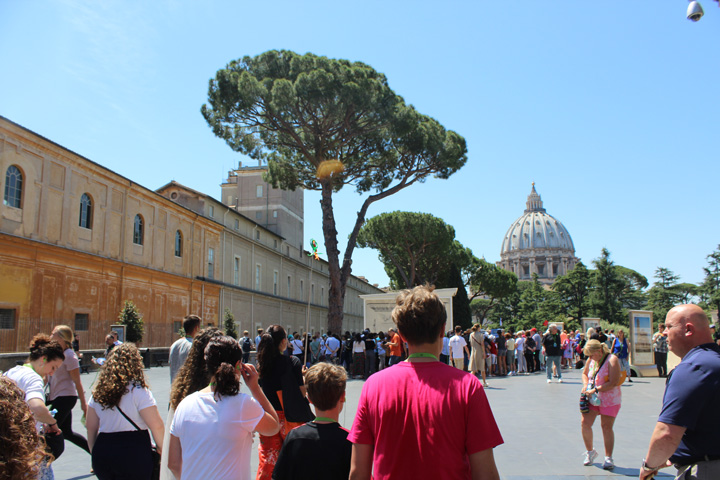
Taking in a scenic courtyard at the start of the tour.

If you live in DC: There's a copy of this outside the Hirshhorn.
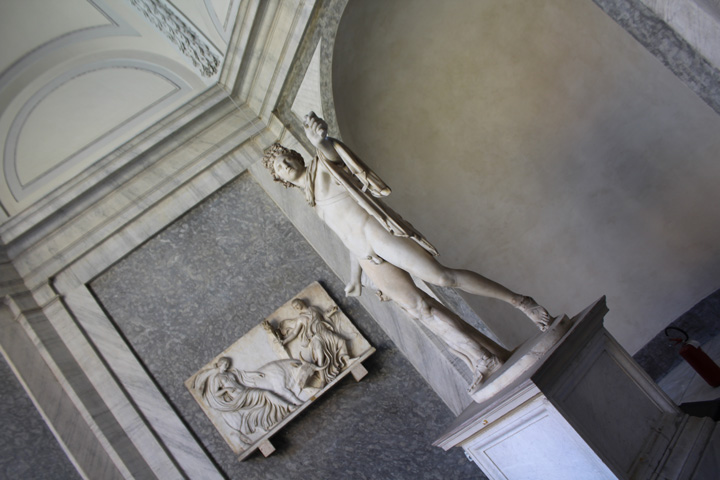
The statue that started it all: The Apollo Belvedere, one of the first stops on the tour.

A typical scene from our tour: stunning room, priceless art, sweating crowds.
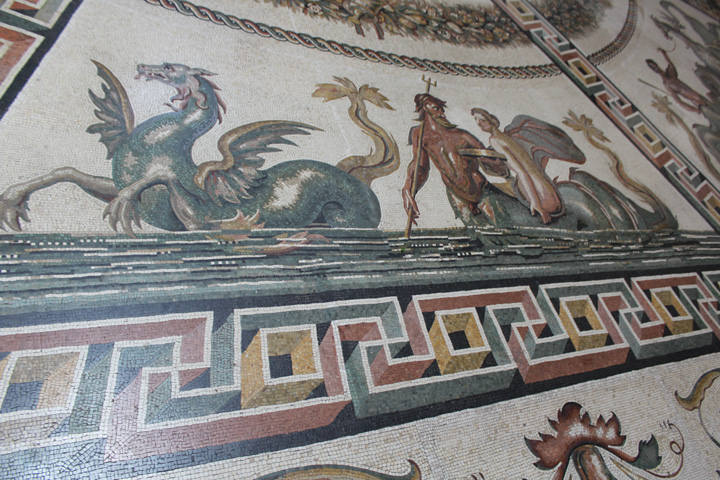
This is just one of the floors at the Vatican Museums. Just something you walk on. Mind-blowing.

The pope uses this for guac when he hosts his Super Bowl party.

My personal favorite, the overwelmingly ornate map room.
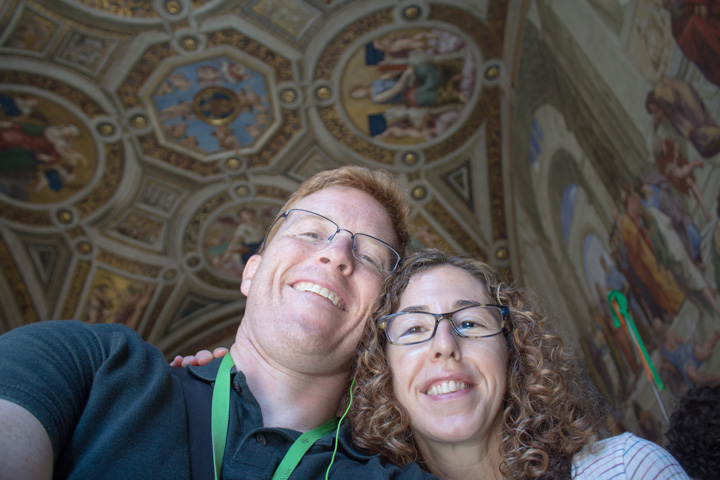
In the Raphael rooms. I like to think he would have captured my double chin.
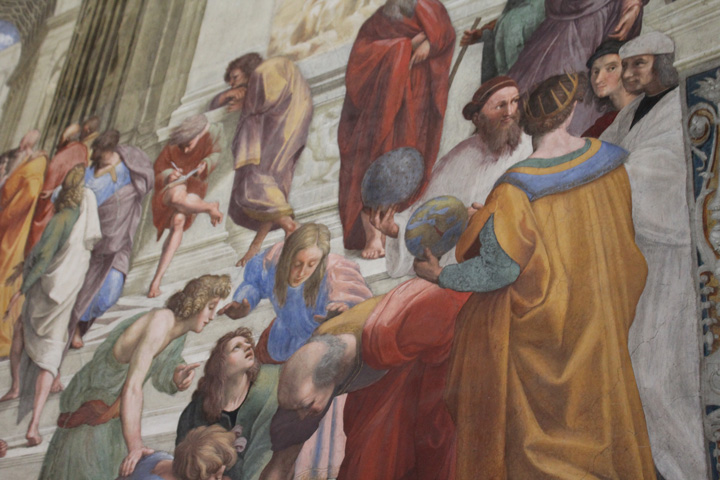
A famous scene from the Raphael rooms -- the guy top-right in the black cap is supposedly Raphael.
The (minor) tragedy of the Vatican Museums is that you see an astonishing array of wonders, but for a very short time. Barbara started our tour in another section of the visitor center, with a primer on the last stop on the tour: the Sistine Chapel. The notion was that she could never convey this information near the chapel itself, on account of the throng of humanity. She had access to a video terminal, so we got the truncated but fascinating story. Michelangelo was reluctant to take the job when it was offered by Pope Julius II. He was a sculptor of great renown, but not a particularly experience painter. However, as the emissary of God, the pope has some leverage, and Michelangelo eventually knuckled under. He at least won a few concessions: he would work alone, with very few apprentices or assistants monitoring his work. The beauty of the chapel is that you can see his development as a painter. As he moved from one side of the room to the other over four years, you can see his skills develop. He figured out the proper scale of the figures, for people standing on the floor below. He incorporated more and more 3D, plane-breaking effects. And he (maybe) incorporated a little revenge on Julius II: the pope's likeness seemed to be on a figure whose penis was getting chomped by serpent, and the butt of God himself was directly over the spot where the pope would be seated.
But those were notes for the future. The trek through the museum started with the Apollo Belvedere -- the first statue in the Vatican's public collection, which was considered for a long time to be the finest ancient sculpture in existence. Before you ask, yes, it's hilarious that it depicts a pagan god. We had to curb stomp only 7 strangers to work our way around the courtyard to get a good look. And that was pretty much the vibe for the whole visit. You see some astonishingly beautiful art, but you don't want to die of heat stroke or trampling, so you move on pretty quickly.
Which isn't to say it isn't great. Personally, I think the beauty of the Vatican Museums is that the building itself is art. You're not in a sterile modern art space; for most of the tour, the walls, ceilings and floors are covered with frescoes, carvings and mosaics. They're all astonishing in their own way. If the individual paintings or sculptures don't get you, the sheer volume will, as you walk through room after room of art on display in a room that clearly has more value than 99.99 percent of the world's homes. One personal highlight was the "map room," a dazzling gallery with frescoed vaulted ceilings, where the walls were adorned with painted maps of the world according to Rome. Literally. For example, a map of Sicily, south of Rome, was hung with the south side up -- to reflect the perspective of Rome, the true center of the universe.
The Raphael rooms also were fantastic. Julius II wasn't resting on his heavenly laurels after commissioning the Sistine Chapel. He also wanted a nice bachelor pad, where he could entertain the ladies. He commissioned the very young artist Raphael. Barbara painted a vivid picture of the contrast between the Vatican's master artists: Michelangelo was long-lived, very eccentric, grumpy and did not work well with others; he locked out all the people initially hired to help him in the Sistine chapel. He didn't take on students. Raphael was gregarious and died of "loving too many women" -- i.e. a copious amount of VD -- at age 37. Raphael worked in the shadow of Michelangelo, but revered him: He painted his colleague into the famous wall showing a gathering of history's great philosophers and thinkers. (He also painted himself into the scene, but if you die of syphilis at 37 you admittedly are pretty great at one thing, at the very least.)
We saw these things, then moved through the modern art collection, which was nice, if more pedestrian. I love modern art, but it's hard to have your mind blown after walking through miles of corridors filled with the greatest hits of old-school art. Then we ran the tourism gauntlet that is the Sistine Chapel -- Barbara's preview made the experience a million times more fulfilling. The finale? Well, that was just the most important Catholic church on the planet.
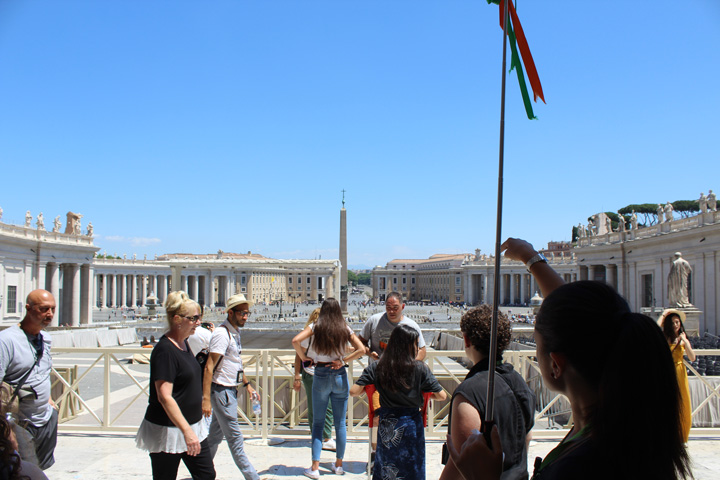
Barbara shows us St. Peter's square from the pope's perspective and praises Bernini.
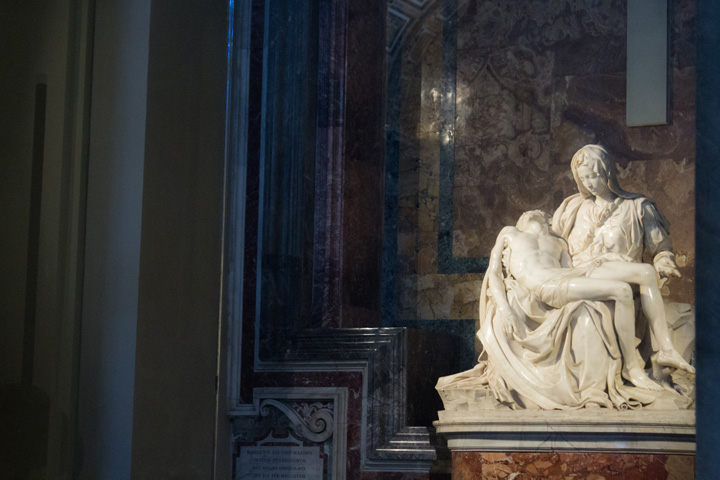
Inside St. Peter's, a look at Michelangelo's Pieta.
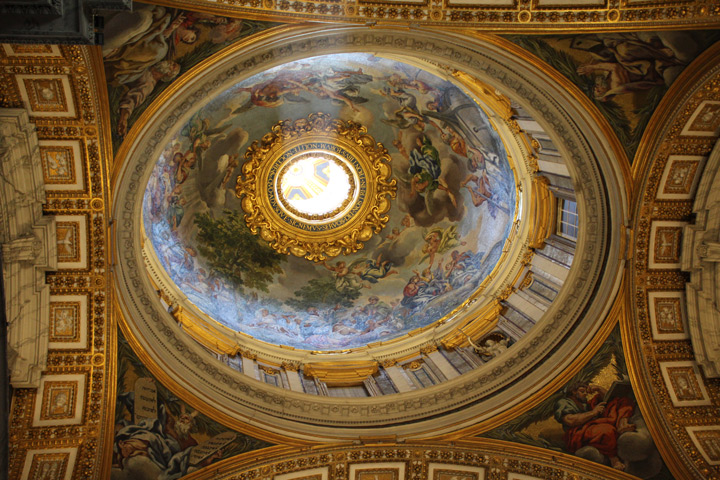
Heads up! No matter what way you look in St. Peter's your mind will be blown.
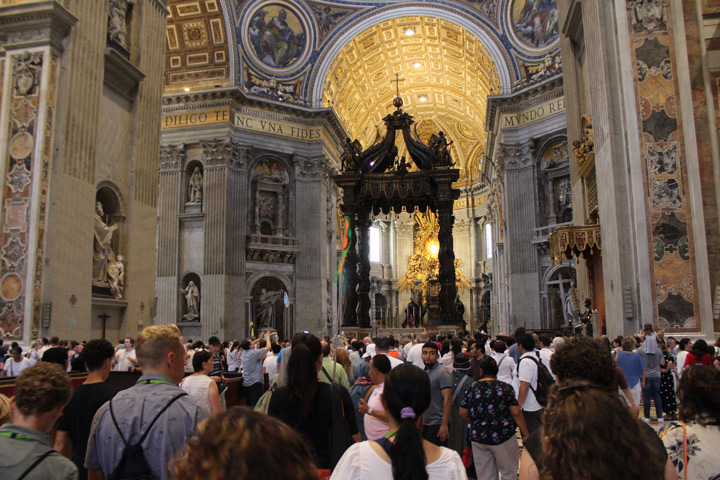
Bernini's famous ... uh ... altar type thingy, I guess.
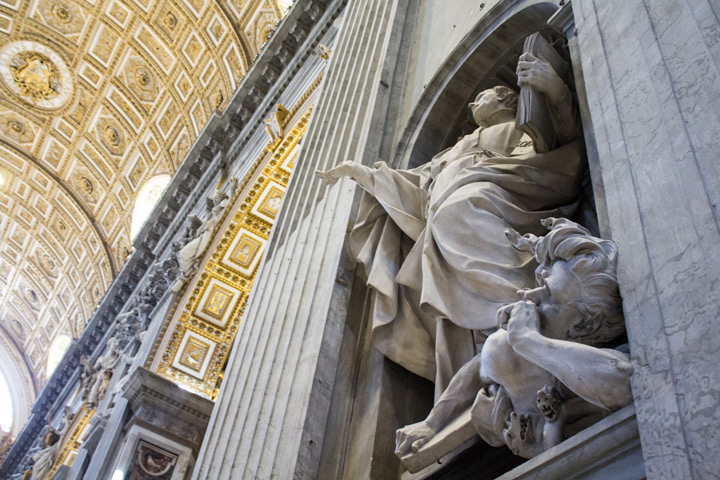
Just your typical St. Peter's niche. They color to the edge of the page ...
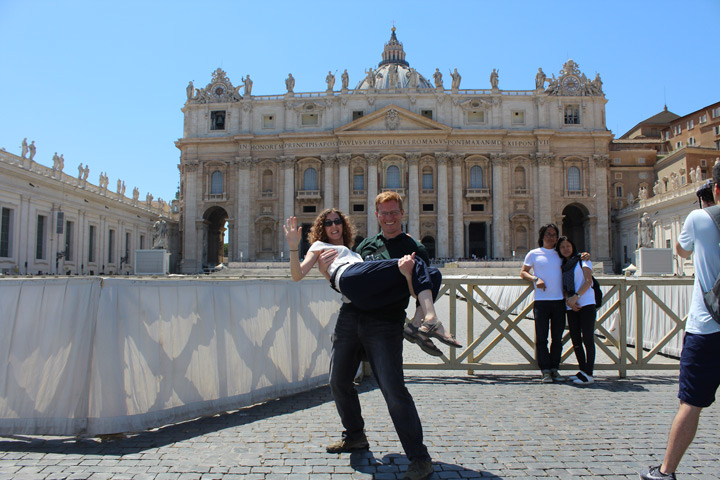
Where there was one set of footprints, I carried her.

Looking back at Castel Sant Angelo, heading to lunch on the Tiber.
The latest version of St. Peter's is pushing 500, but still looking really solid for its age. God does a nice job maintaining his house. We started outside, standing under the famous balcony and getting a (slightly lower) Pope's-eye view of the plaza. Barbara sang the praises of Bernini, the father of the ornate Baroque style and a master of optical illusions. In the generation after Michelangelo, he did his some of his finest work on the plaza outside St. Peter's, while also adding flourishes to the inside. (He designed the very famous chuppah-looking thing in the middle of the basilica, among other things.) St. Peters is the address of Michelangelo's Pieta, one of the most famous sculptures in Western history. It lives behind a thick wall of plastic, thanks to a mentally deranged Hungarian who attacked it with a hammer in 1972, while shouting that he was Jesus. There's one in every crowd, right? Our timing was a little off, so we didn't get to walk through the Porta Santa. The "holy door" is sealed by concrete most of the time, but every 25th year, they break the seal. Walking through it supposedly wipes clean your sins, like a drive-through confessional. Why the Vatican rations this amazing technology is beyond me.
But these are just some of the features that happen to pop out. St. Peter's is immense, and no surface has escaped decoration. Every pillar has a niche and every niche has a statue, showing the saints in all their wacky glory. When a regular wall won't do, they put in a mosaic (including the last thing Rafael ever made before dying). If there's a reasonable-sized alcove they entombed someone there. Maybe the only disappointment was the crypt, where a bunch of popes are stashed without all the romance and majesty of the ground floor. You could write a treatise on any one thing in the Vatican and St. Peter's, and in the span of a few hours you'll see roughly 1.4 million things. The memories blur together, but the questions still stand out. How much is it all worth? How much stuff did the popes really need? Are we SURE Jesus was cool with all this? And are we bad Catholics for enjoying it so much? Can we buy a refrigerator magnet? And could our guide recommend a good dinner spot?
To answer a few of those: Allyson was definitely a bad Catholic, on account of being Jewish. But she enjoyed her trip to the opponent's locker room. You can get a magnet. The Vatican has its very own post office, what with being a sovereign state and whatnot. The post office is conveniently surrounded by some nice gift shops. And yes, Barbara went above and beyond to recommend a restaurant not far from our hotel that real Italians (such as Barbara when using her actually name) like to frequent. She was great.
Dinner was not the pressing concern, however. Our energy reserves from breakfast were pretty much gone after touring an entire country in one afternoon, so we had to find a late lunch. After strolling past Castel Sant Angelo -- which I guess we'll tour on the next visit -- we went down to the banks of the Tiber and picked one of the Lungo Il Tevere summertime pop-ups. We talked about religion while recharging, and while I can't remember the conclusions, we were there for almost an hour so we probably resolved all the major moral and philosophical problems ever posed by man.
With our time in Rome winding down, we gave up the rest of day to the Holy Roman Checklist. The Spanish Steps are pretty much as advertised. They're steps. We have steps in America -- nice ones! -- but the mostly connect a Panera to a Starbucks. The Spanish Steps connect one plaza, where the Spanish embassy to the Holy See is located, to a higher plaza, where a very nice looking church is located. For kicks they also put in a cool fountain at the bottom. The fountains of Rome were designed to work on natural water pressure, and the location of the Piazza di Spagna makes it tough to arrange a thunderous cascade from above. So they allegedly opted for a low-pressure option. Pietro Bernini -- the father of the Vatican Bernini -- imagined the Fontana della Barcaccia as a sinking ship, taking on and leaking water at the same time. I honestly found it more memorable than the Trevi Fountain, maybe because Allyson almost fell in it while trying to refill her water bottle.
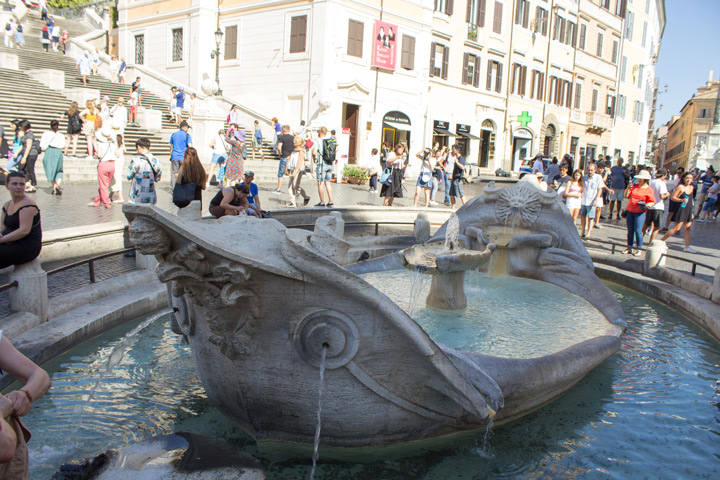
The foot of the Spanish Steps is home to my favorite fountain.
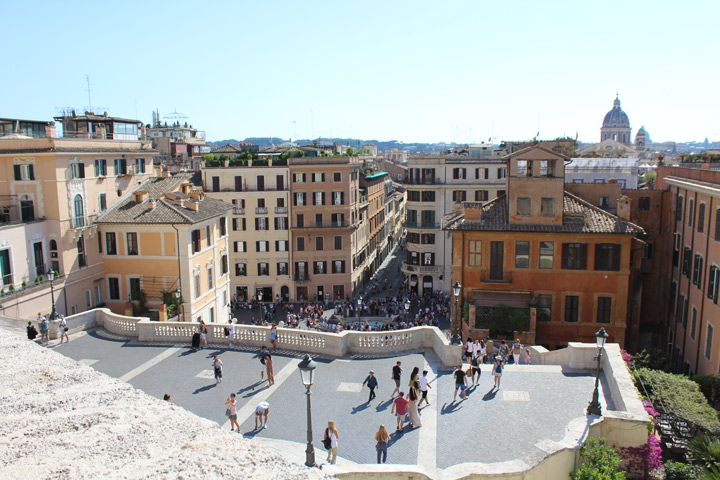
The view from the top of all 135 of the Spanish Steps.

On the edge of Villa Borghese, outstanding views of Rome.
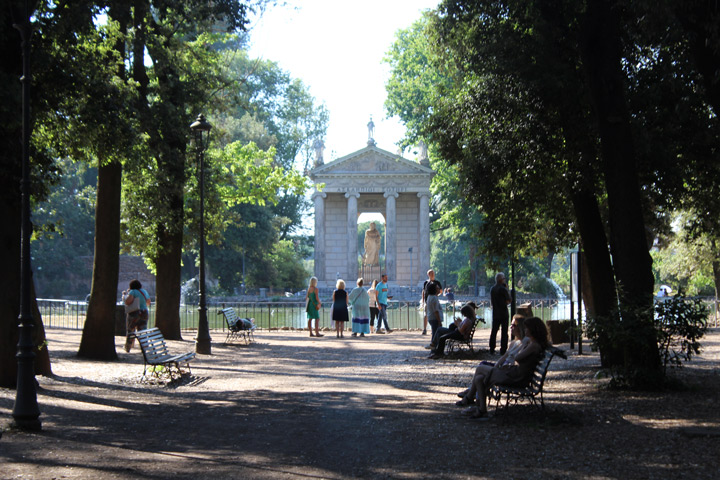
Approaching the rowing pond in Villa Borghese.
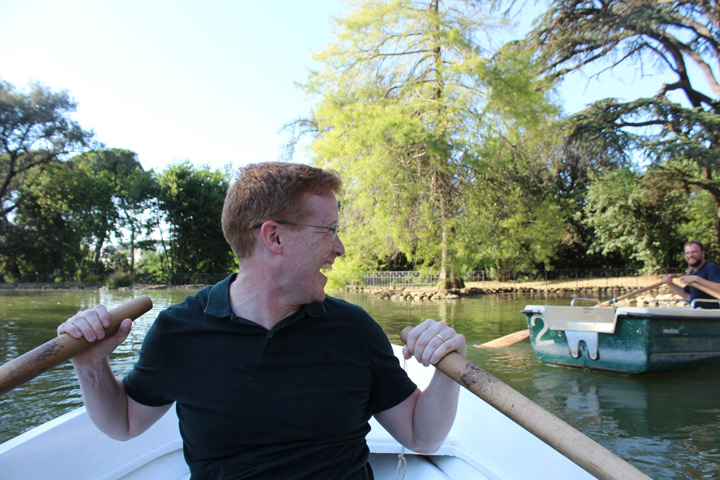
A near collision! Note the person taking this picture should have been warning me. Ahem.
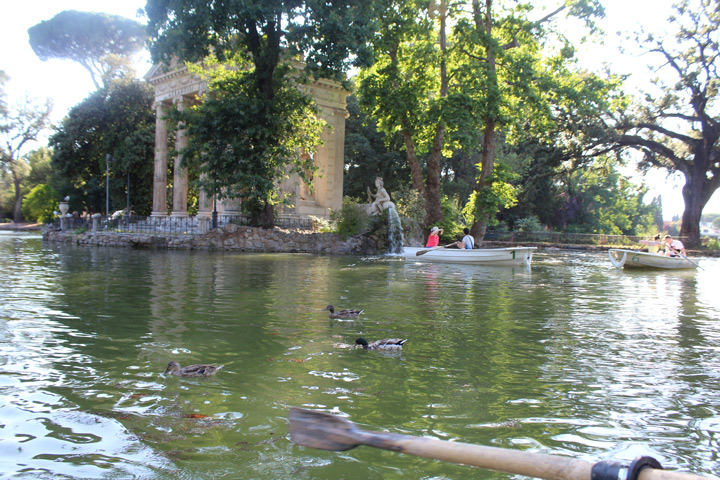
The quaint temple in the middle of the Villa Borghese rowing pond.
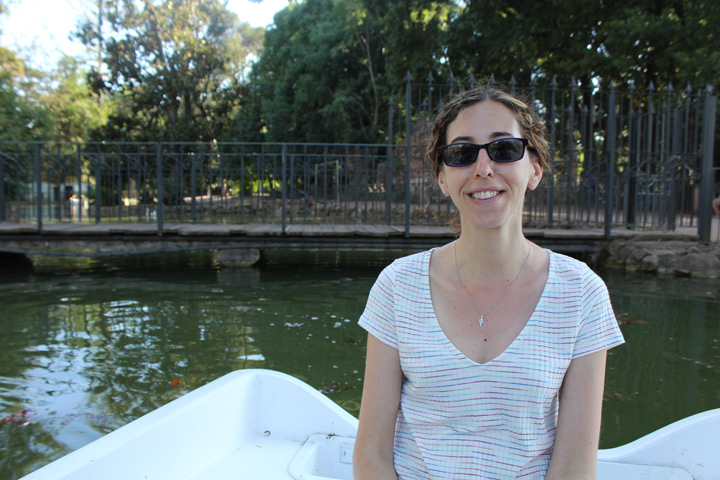
Getting rowed around and loving it.
We got to steppin' and climbed to the top. Allyson counted 135 steps, which led to the nine-years-into-marriage realization that my wife always counts stairs. Everywhere. It hasn't sprouted into a much deeper psychosis yet, but one day she'll turn to me at the top of staircase, say "That should be enough," and then shove me down them. Until then we're deeming the habit cute.
The plaza at the top had a road leading to the Villa Borghese gardens. They're like the Farnese Gardens, only bigger: In 1605, Cardinal Scipione Borghese, nephew of Pope Paul V and patron of Bernini, wanted some gardens. He owned a vineyard -- what self-respecting cardinal wouldn't? -- so he hired the appropriate artisans and went to work. By papal and Roman logic, anything worth doing is worth overdoing exponentially, so the results were spectacular. It was turned over to the public in the early 20th century, offering great views of central Rome, and enough amenities to fill a Jane Austen novel.
The sculpture gallery in the park is supposedly one of the greatest in the world, and you aren't visiting without tickets reserved months in advance. But they do have an outdoor sculpture park, packed with stone busts of historic figures. Want to see the face of Machiavelli, with the nose broken off so he looks like Voldemort? Of course you do! Both figures understood that it was better to be feared than loved. The park has nice gardens, tree-lined biking paths, and gelato stands aplenty. Not to mention a boating pond!
The most traumatic vacation experience in Jaffe-White history involved a boat. We rented a low-powered motorboat to tool around the canals of Amsterdam, and to make a long story short, I was a slightly worse captain than Joseph Hazelwood. There was a boat-on-boat collision leading to an eternal amount of shame. So it takes a lot to get me at the helm these days, but the Villa Borghese boating pond seemed like a safe bet. It's small, there is no current, and the only option is rowboats. You'd have to be a world class dunce to screw up.
Naturally, we almost crashed. In a city like Rome, I would guess that God is your co-pilot, but if you're rowing a boat you still need a mortal facing forward, telling you when you're about to smash into something. Allyson ignored her sacred duty, and we almost sent a lovely couple into a picturesque pond filled with duck poop. Fortunately my Mercury-like reflexes kicked in and an international incident was avoided. Praise be unto me. We rowed around for half an hour, past the ducks and the turtles, and around a little island with a temple to the "god of medicine," who fortunately was not enlisted to save anyone from a bacterial infection caused by involuntary pond-swimming. Allyson joked that she felt like a princess, getting rowed around a lake. I got to feel like the manservant of a princess. Everyone had a great time, and we ended the day by walking back to the hotel. We covered 7 miles on foot that day, during a scorching heat wave, while dressed for the Vatican. So we earned our drinks on the hotel roof.
Barbara did not steer us wrong for dinner. Da Tonino wasn't far from the hotel, and there was no way we would have chosen it without a recommendation. It was tiny, about the size of a row home, on a side street, with just a few outside tables and a handful more crammed inside. All the other customers were speaking Italian, which was a pretty good sign that after just four days in the country we were pretty much authentic locals. The food was outstanding -- I forget what Allyson had, but I had softball-sized meatballs and some amazing gnocchi. The conversation was better. Close tables can be a good thing, if you're in the right frame of mind. We got wrapped up in a long conversation with Marco and Alice, the next table over. They were a stunningly good-looking long-distance Italian couple, meeting up for a date in Rome. Both had studied in or visited the U.S. -- Alice, strangely enough, spent a lot of time in Minnesota -- and they spoke impeccable English. They were both from Florence. Marco operated a flatbread chain restaurant with five locations, while Alice was studying crime and international law. They chatted a bunch about the world and asked us what we thought about Trump. (They didn't love him; but loved his China policy.) They also asked our opinion on Amanda Knox, which was kind of funny, because we didn't really have one. They were beautiful and young people, and for us okay looking less-young people, it was great to have an earnest conversation with strangers. There's nothing wrong with chatting up people you'll never meet again. We should all do more of it.
And that was it for Rome. It's the Eternal City, but hotel rates being what they are, it's tough to stay there eternally. We at least enjoyed the history, marveled at the opulence, sweated our asses off and enjoyed the local cuisine. Visitors 2,000 years ago probably did the exact same things. The more things change, the more they stay the same.
On to Croatia.
